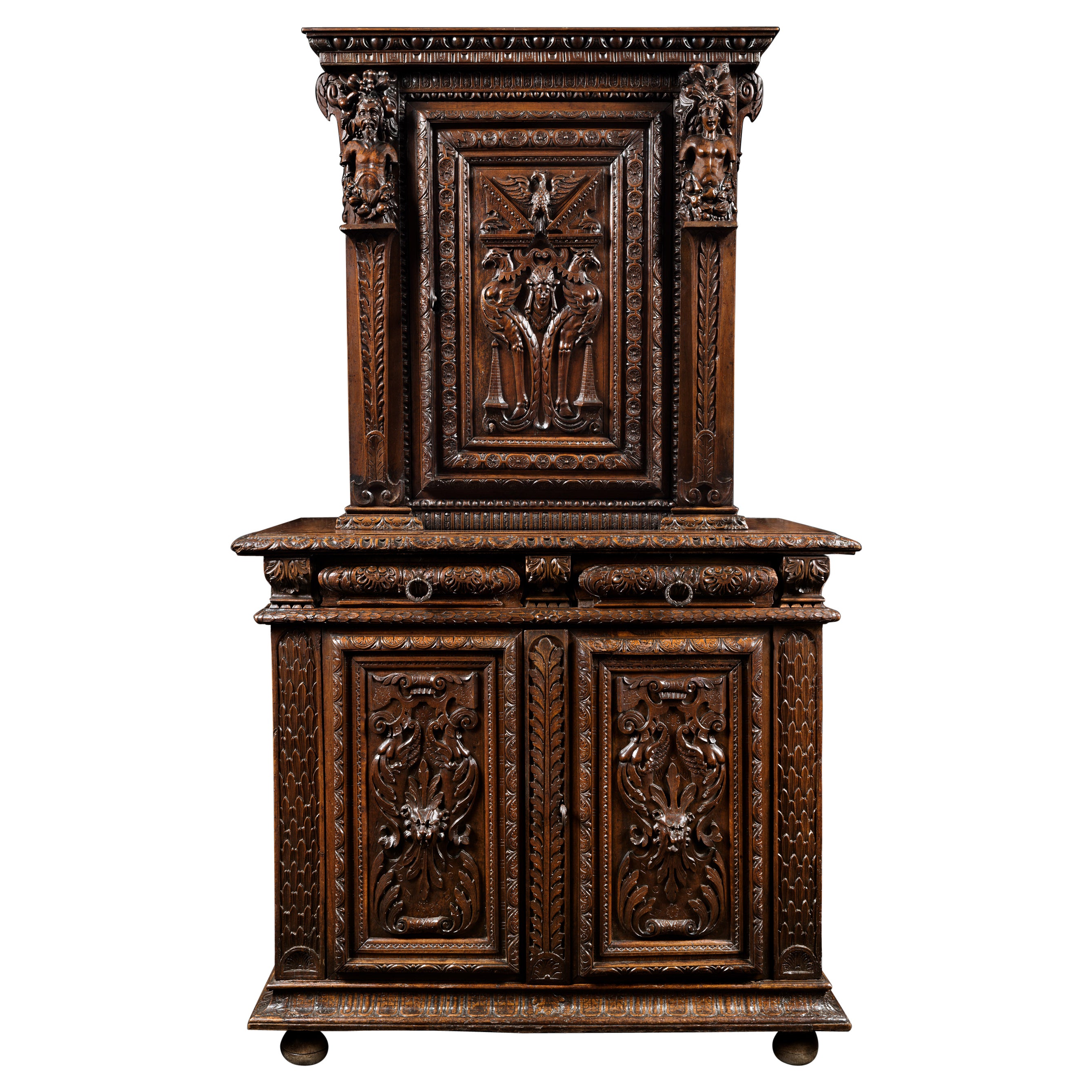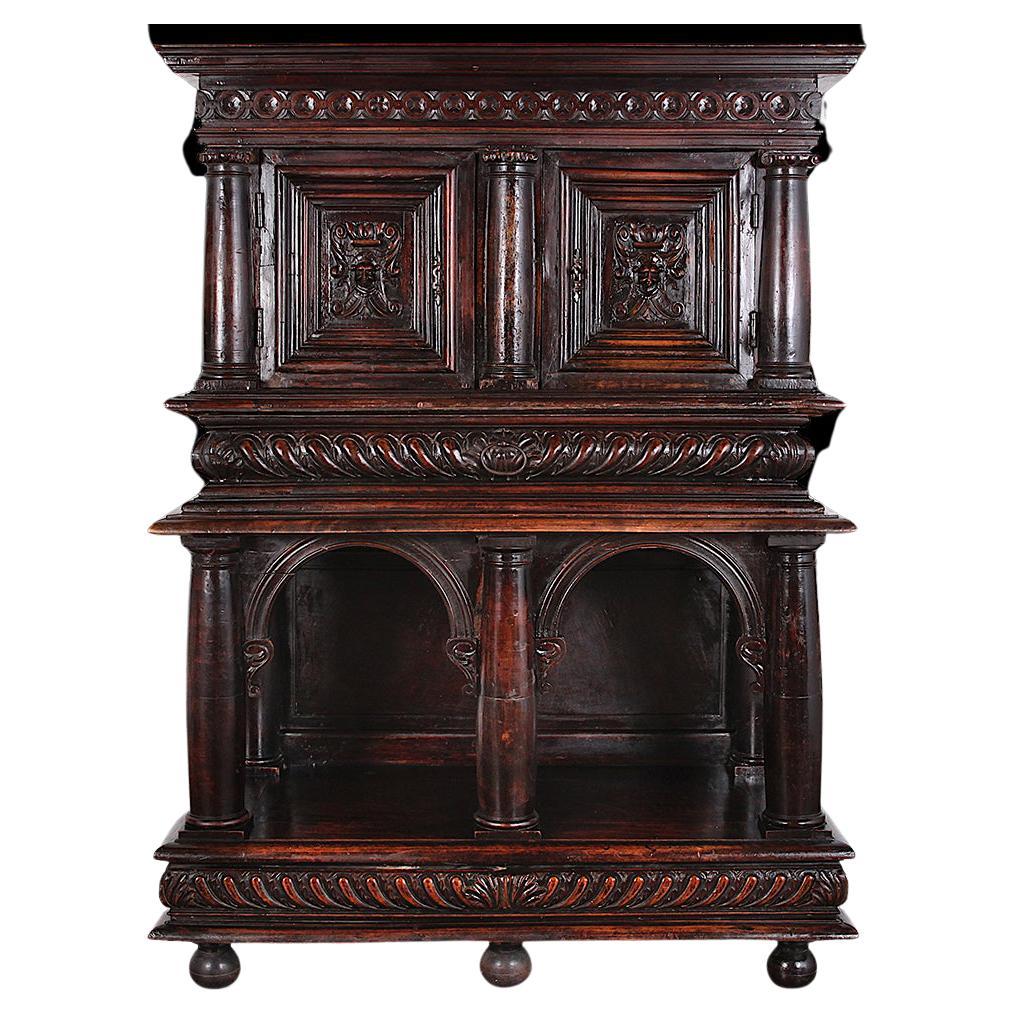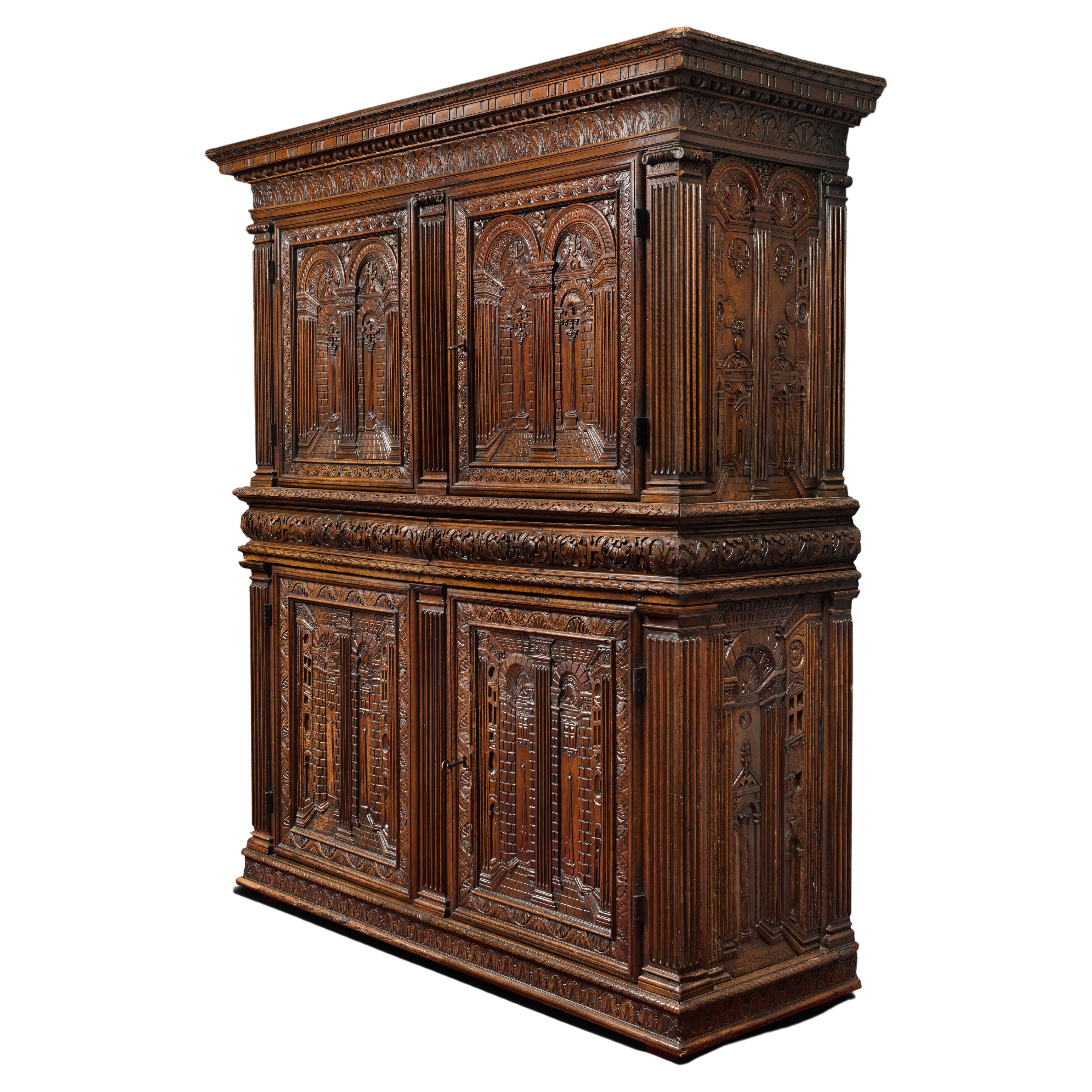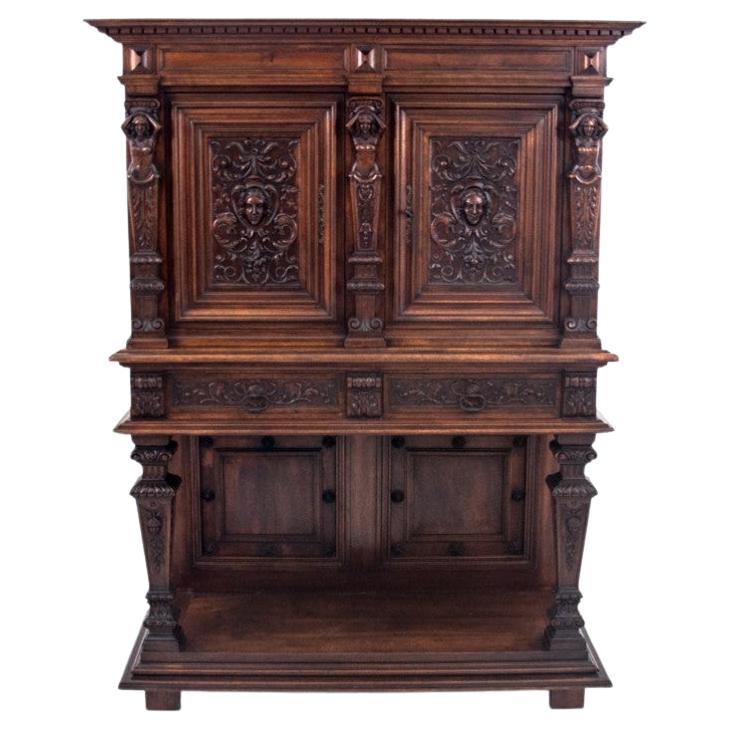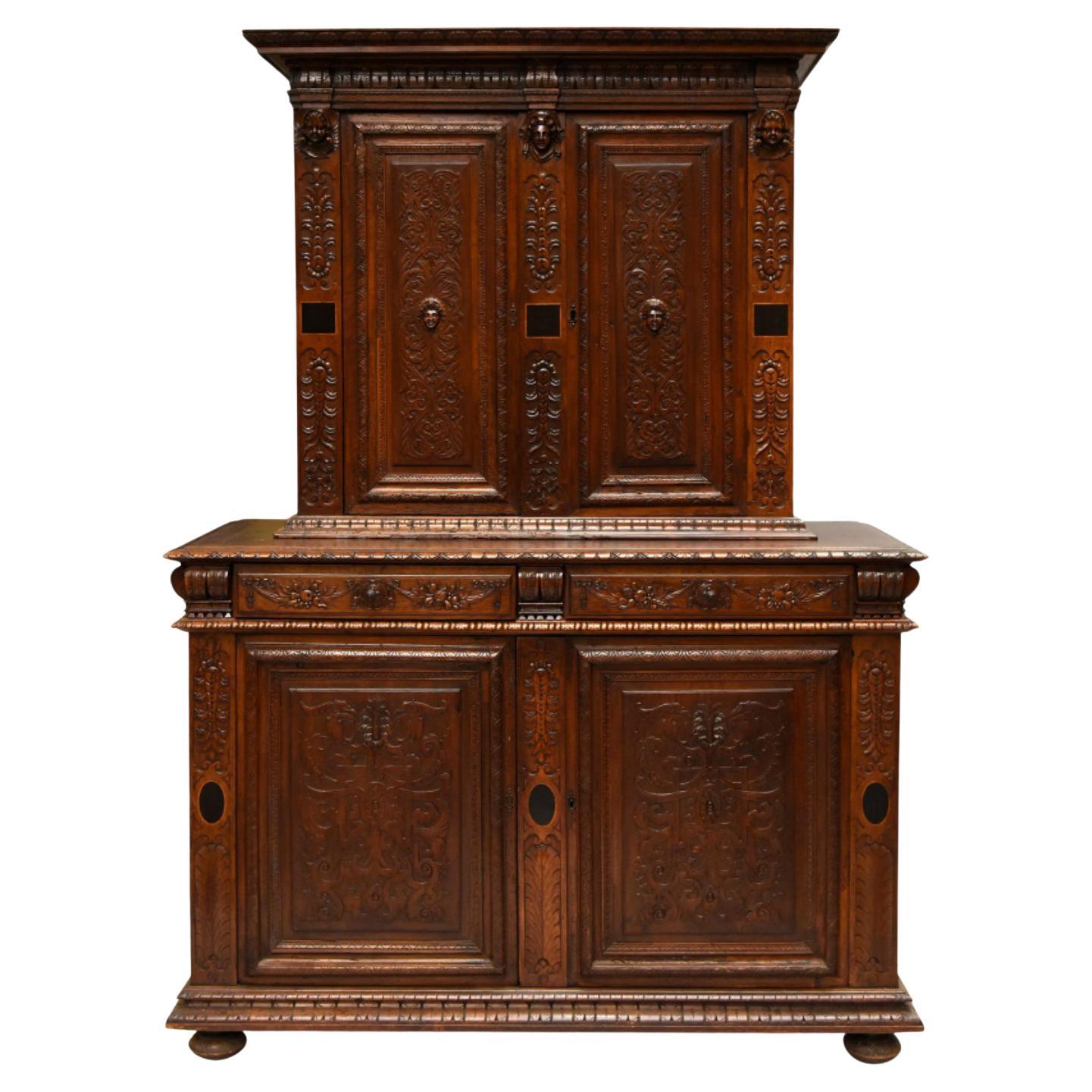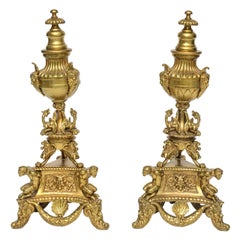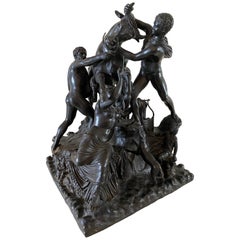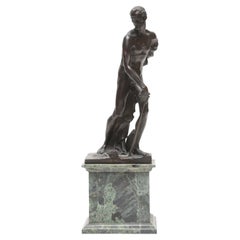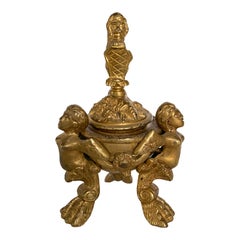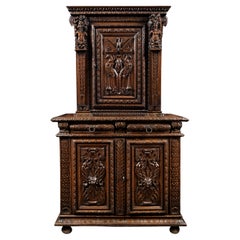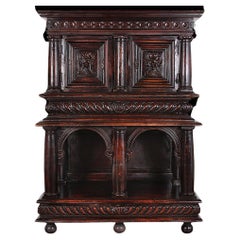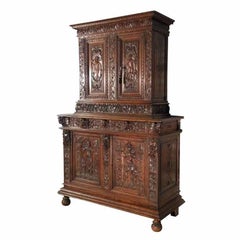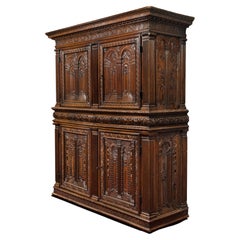Items Similar to Very Rare and Important 16th C. French Renaissance Cabinet or Dressoir, ca. 1580
Want more images or videos?
Request additional images or videos from the seller
1 of 8
Very Rare and Important 16th C. French Renaissance Cabinet or Dressoir, ca. 1580
$17,600
$28,00037% Off
£13,303.42
£21,164.5337% Off
€15,288
€24,321.8137% Off
CA$24,507.89
CA$38,989.8337% Off
A$27,264.03
A$43,374.5937% Off
CHF 14,292.14
CHF 22,737.5037% Off
MX$333,159.73
MX$530,026.8537% Off
NOK 181,992.62
NOK 289,533.7137% Off
SEK 171,320.87
SEK 272,555.9337% Off
DKK 114,119.07
DKK 181,553.0637% Off
Shipping
Retrieving quote...The 1stDibs Promise:
Authenticity Guarantee,
Money-Back Guarantee,
24-Hour Cancellation
About the Item
Walnut with verde antico marble inlay, with two wholly carved draped female allegorical figures within arched recesses, and a bas-relief on the central door. Rich and heavily carved sculptural ornamentation includes pilasters, columns, arches, caryatids, pediments, rinceaux, scrolls, garlands, dolphins, putti, and a grotesque mask. Incredibly, the cabinet retains nearly all of its original period elements. It is constructed in two parts, with the upper cabinet containing three compartments with locking doors, and the lower stand fitted with a frieze drawer above four columns tapering slightly at the top and bottom, resting on a rectangular plinth with moulded edge and bun feet.
The intricate carving of classical relief figures and inlaid marble panels which adorn this cabinet are characteristic of the French mannerist style employed by craftsmen of the seconde école de Fontainebleau dating from the late 16th century. Inspired by the work of the Italian artists Rosso Fiorentino, Primaticcio and Cellini who worked for François I at the Château de Fontainebleau in the 1530s and the ornamentalists who had assimilated these influences, such as Jacques Androuet du Cerceau (1510-1584) and Jean Goujon (1515)-1562), the architect, sculptor and cabinetmaker Hugues Sambin (ca. 1520 – 1601) borrowed freely from this répertoire of design for the adorment of furniture. Androuet du Cerceau’s flamboyant and splendidly-fashioned furniture was characterized by the use of bold human figures and by surfaces completely covered with carving.
Related examples are in the collections of the Getty Museum, the Victoria & Albert Museum and the Louvre.
For a similar illustrated example, please see:
M. Riccardi-Cubitt, The Art of the Cabinet, London, 1992, page 26, ill. 2
References:
Ruth Constantino, French Antiques, Clarkson Potter, 1961
Alain Erlande-Brandenburg, catalog of the exhibition Hugues Sambin: Un Créateur au XVIe siècle (vers 1520-1601) at the Musée National de la Renaissance, Château d'Écouen, October 2001 – January 2002
Simon Jervis, Printed Furniture Designs before 1650, Furniture History Society
Jacques Thirion, Mobilier Moyen Age Renaissance en France, Editiyons Faton.
Sir Francis Watson, The History of Furniture, Crescent Books, 1976
- Similar to:Jacques Androuet Du Cerceau (Maker)
- Dimensions:Height: 61 in (154.94 cm)Width: 49 in (124.46 cm)Depth: 18 in (45.72 cm)
- Style:Renaissance (Of the Period)
- Materials and Techniques:
- Place of Origin:
- Period:
- Date of Manufacture:c. 1580
- Condition:Wear consistent with age and use.
- Seller Location:Miami Beach, FL
- Reference Number:Seller: KKF-021stDibs: LU9776801054
About the Seller
5.0
Vetted Professional Seller
Every seller passes strict standards for authenticity and reliability
Established in 1962
1stDibs seller since 2013
154 sales on 1stDibs
Typical response time: 1 hour
- ShippingRetrieving quote...Shipping from: Miami Beach, FL
- Return Policy
Authenticity Guarantee
In the unlikely event there’s an issue with an item’s authenticity, contact us within 1 year for a full refund. DetailsMoney-Back Guarantee
If your item is not as described, is damaged in transit, or does not arrive, contact us within 7 days for a full refund. Details24-Hour Cancellation
You have a 24-hour grace period in which to reconsider your purchase, with no questions asked.Vetted Professional Sellers
Our world-class sellers must adhere to strict standards for service and quality, maintaining the integrity of our listings.Price-Match Guarantee
If you find that a seller listed the same item for a lower price elsewhere, we’ll match it.Trusted Global Delivery
Our best-in-class carrier network provides specialized shipping options worldwide, including custom delivery.More From This Seller
View AllPair Gilt Bronze Andirons in the Style of Andrea Briosco (Riccio)
By Andrea Briosco (Riccio)
Located in Miami Beach, FL
These highly articulated gilt bronze andirons are based on a 16th century design for candlesticks by the great Italian renaissance sculptor Andrea Briosco known as Riccio (1470-1532). Riccio's great masterpiece is the Paschal candelabrum in the cathedral of Padua which contained mythological creatures, satyrs and grotesques. Despite the shocking motifs, the church of Sant Antonio...
Category
Antique 19th Century Italian Renaissance Revival Andirons
Materials
Ormolu
$2,000 Sale Price / set
55% Off
Italian Bronze Sculpture Group of the Farnese Bull, 19th Century
Located in Miami Beach, FL
This Italian bronze sculpture group of the Farnese Bull, after the antique, is handsomely modeled and detailed throughout with a lovely blackish to cocoa ...
Category
Antique Mid-19th Century Italian Neoclassical Figurative Sculptures
Materials
Bronze
$6,000 Sale Price
20% Off
Venetian Bronze Statuette of St. Jerome, 18th/19th Century
Located in Miami Beach, FL
Bronze statuette of St. Jerome, or St Hieronymous, in the manner of the Venetian sculptor Alessandro Vittorio (1525-1608) by the lost wax technique of bronze casting, which leaves a ...
Category
Antique 18th Century Italian Baroque Figurative Sculptures
Materials
Marble, Bronze
$2,080 Sale Price
72% Off
19th Century Italian Grand Tour Bronze Inkwell
By Severo Calzetta da Ravenna
Located in Miami Beach, FL
After a 16th century Venetian design, winged putti with taloned legs support a turned bronze inkwell covered with a lid decorated with masks and garla...
Category
Antique 19th Century Italian Renaissance Revival Inkwells
Materials
Bronze
$760 Sale Price
20% Off
18th Century Ruins Landscape Attributed to Bartolomeo Pedon
Located in Miami Beach, FL
Attributed to Bartolomeo Pedon (Italian 1665-1732)
"Ruins", circa 1700
Oil on canvas
69.5" x 52" inches framed
61" x 43.5" inches unframed
Pedon was born in October 1665. In 1716, he became part of the Fraglia, a guild of Venetian painters. He lived the lifestyle of a Bohemian and had a strong taste for poetry. Pedon spent most of his career as a painter in Padua, in the Monastery of San Benedetto, and died in February 1733.
The present painting, attributed to Pedon, relies on the late Seicento landscape culture of Northern Italy. The artist was clearly influenced by painters like Johann...
Category
Antique 18th Century Italian Baroque Paintings
Materials
Canvas
$11,200 Sale Price
25% Off
Pair of Bronze Plaquettes with Putti, Signed Clodion, French, 19th Century
By Claude Michel Clodion
Located in Miami Beach, FL
In the first plaquette the putti drink wine, eat grapes, make music and wrestle in a field with a round temple in the background. Signed CLODION
In the second plaquette, young sat...
Category
Antique Mid-19th Century French Neoclassical Figurative Sculptures
Materials
Bronze
$960 Sale Price / set
56% Off
You May Also Like
16th Century French Carved Renaissance Cabinet
Located in Saint-Ouen, FR
Rare carved Renaissance cabinet
Period : 2nd half 16th century, ca. 1570
Origin : France, Burgundy or Languedoc
This cabinet embody the produ...
Category
Antique 16th Century French Renaissance Cabinets
Materials
Walnut
French 17th Century and Later Cabinet on Stand
Located in Vancouver, British Columbia
An ornately-carved walnut 17th century and later French cabinet on stand, the top with a pair of carved doors and paneled carved sides with co...
Category
Antique 17th Century French Renaissance Cabinets
Materials
Walnut
French late 16th century Renaissance Walnut Deux-Corps cabinet
Located in Troy, NY
Beautiful French Renaissance cabinet in two parts. The top part with two carved doors featuring classical figures opening to an interior fit...
Category
Antique 16th Century French Renaissance Cabinets
Materials
Walnut
Important Renaissance Cabinet from Lyon 'France' with a Decor of Perspectives
Located in Saint-Ouen, FR
As soon as 1540 France's second Renaissance is in the making, intimately linked to the rediscovery of the Antique world. The development of the printing and engraving industry allows the spread of artworks and models in many cities and countries. The Italian influence can be perceived in every artistic field. While the French king entrust the most talented Italian artists with major projects such as Il Rosso or Primaticcio in Fontainebleau, French artists also travel to Italy to form themselves to this new style. In Italy they get acquainted with the work of Leo Battista Alberti the first to theorize perspective (De Pictura, 1435-36) and architecture (De re oedificatoria, 1541). Those two publications would have a revolutionary impact on arts.
Furniture is marked by the work of the most famous Italian architects of the time as well as French architects. Indeed Philibert de l'Orme competes with Alberti and by the end of his life publishes several treaties including one devoted to a theory of architecture (1567). Unfortunately he would not live to complete the second volume. In this treaty he expresses his interest for mathematical norms applied to architecture, copied from the Antique. His journeys in Italy allowed him to accumulate the most sophisticated references. Jean Bullant, another architect of great talent also theorizes his practice. He establishes rules characterizing Greco-Roman art staying faithful to Vitruvius.
Following this new inspiration the structure of furniture evolves. From then on appear columns, capitals, cornices, friezes and architraves. The ornamentation uses this inspiration as well with egg-and-dart, palm leaf and rose adorning the most beautiful pieces.
In Lyon, crossroad where meet merchants from everywhere those new experiments are welcomed. Lyon florishing printing industry allows the spreading of models and treaties essential to the artist's work. Thus the first publication of Vitruvius' De Architectura in France would be printed in Lyon in 1532.
Artists from Lyon rediscover and familiarize themselves with the Antique knowledge very early. They adopt those new ideas and use them in their own creations. Lyon cabinet-makers re interpret Antique architecture and Italian Renaissance palaces to give their pieces a pure and harmonious architectural structure. Grooved pilasters are particularly favored. They are topped by capitals of diverse orders always respecting the sequencing with simpler ones for the lower levels and the richest ones on the higher levels. As for the ornamentation, one of the great distinctiveness of Lyon workshops remains the architectural perspective illusions, drawing inspiration from Tuscany.
True masterpiece of the Second French Renaissance this important cabinet illustrates Lyon workshops' taste for fine Italian architecture inspired by Antiquity. An architectural perspective of great quality is treated in symmetry on each panel.
This two-bodied cabinet without recess stands on four rectangular feet. The base comprises a molding, a palm leaf frieze and is bordered by a braid.
The lower body is divided by three grooved pilasters with Tuscan capitals framing two door-leaves. The two panels are encircled by a moudled frame with palm leaves. They are finely carved with a decor of fantasized architecture depicting an Italian Renaissance palace erected symmetrically on each side of a grooved pilaster. On the ground floor a door opens through a stilted arch while the stories are opened with mullioned windows, dormers and occuli. Two large pegged-boss cladded pillars support the entablature enriched by a palm leaf frieze upon which stands an arch whose coffered intrados is centred by a rose. Behind this arch a pyramid appears, standing in front of a second facade with a window topped by a broken curvilinear pediment under a cul-de-four with a shell.
The checker flooring gives depth to the low-reliefs creating vanishing points structuring the panels and guiding the eye of the observer.
A thin laurel braid highlights the belt of the cabinet where are located two drawers. Their facades are adorned by palm leaves in hoops.
The upper body is encircled with palm leaves. The same ternary division as in the lower body appears. However, the pilasters are topped by Ionic capitals with volutes and egg-and-dart. The door-leaves are framed with flowers. On the panels the artist has designed another architectural decor. On the foreground open two arches on top of grooved pilasters with rectangular capitals adorned with palm leaves. The arches are enriched with braids and the coffered intrados bears a decor of roses. The spandrels also bear a flower decor. In the background another arcature hosts a fluted grooved column topped with double basket acanthus capital, characteristic of Corinthian order. The triangular pediment is interrupted by a choux bourguignon.
A large cornice crowns the cabinet. It stands on pilasters and forms an entablature comprising a palm leaf frieze and an egg-and-dart, triglyph and palm leaf cornice.
The cabinet's sides have also been carefully considered. The lower body's panels are enriched with an arch rising above a broken pediment portico hosting a twisted column. Flowers garnish the spandrels. An architectural facade completes the decor. The upper body's panels present two arches supported by a facade opened with dormers and mullioned windows as well as cartouches (one bears the inscription 1580 dating the cabinet) suggesting the interior of an Italian Renaissance palace, confirmed by the chandeliers. The flooring leads our gaze to a second arch with a broken curvilinear pediment where stands a flower vase. This arch opens onto a perspective of another facade along a road.
Inside the cabinet, on the lower body door-leaves appear two designs. On the right door is depicted a Crucifixion. Saint Mary and Saint John flank the Christ on the cross. In the bottom part is inscribed « Dure uiator abis nihil haec spectacula curas / Pendenti cum sis unica cura Deo. / Tota suo moriente dolet natura Magistro. / Nil qui solus eras caussa dolenda doles. ». The signature [Christoff Swartz Monachiensis pinx[it] / Ioa[nnes] Sadeler sculp[it]] tells us it was made by Johan Sadeler I (1550-1600) after Christoph Schwartz (1548-1592). This engraving belongs to an ensemble depicting the Passion of Christ Johan Sadeler executed in 1589 after an altar piece painted by Christoph Schwartz for the private chapel of Renée of Loraine, wife of Duke William V of Bavaria. This altar piece made of nine copper panels has been destroyed during the 19th century. The Crucifixion panel once in the centre of the altar piece is the only one that survived and is today kept in Munich's Alte Pinakothek.
On the left door appears Saint Francis receiving the stigmata. The inscription says : « Signastidomine Servum Tuum. Franciscum. Signis Redemptionis Nostrae ».
This Renaissance cabinet with an architectural decor appearing as much in the structure faithful to Antique rules...
Category
Antique 16th Century European Renaissance Cabinets
Materials
Walnut
Figural Renaissance cabinet, France, around 1870.
Located in Chorzów, PL
Figural Renaissance cabinet, France, around 1870.
Very good condition.
Wood: walnut
dimensions: width 131 cm x height 175 cm x depth 52 cm
Category
Antique 1870s French Renaissance Cabinets
Materials
Walnut
Renaissance Cabinet form Lyon 'France'
Located in Saint-Ouen, FR
Condition : Partly dating from the Renaissance. The backs and the drawer’s insides have been re-done.
Historical background
The 16th century is a prosperous period for Lyon...
Category
Antique 16th Century French Renaissance Cabinets
Materials
Walnut
More Ways To Browse
History Of Antique Furniture
Verlys France
Rare French Books
16th France Renaissance
Carved Grotesque
Pilaster Columns
Italian Carved Marble Top Cabinet
16th Century Carved Panel
Verde Antico Marble
Carved Oak Italian Cabinet
16th Century Italian Walnut
18th Century Rare Books
French Chateau Doors
Bas Relief Marble
Heavily Carved Renaissance
16th Century Italian Cabinet
Dolphin Stand
Classical Bas Reliefs
